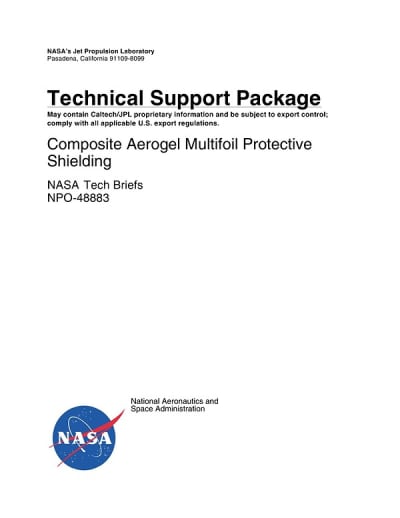New technologies are needed to survive the temperatures, radiation, and hypervelocity particles that exploration spacecraft encounter. Multilayer insulations (MLIs) have been used on many spacecraft as thermal insulation. Other materials and composites have been used as micrometeorite shielding or radiation shielding. However, no material composite has been developed and employed as a combined thermal insulation, micrometeorite, and radiation shielding.
By replacing the scrims that have been used to separate the foil layers in MLIs with various aerogels, and by using a variety of different metal foils, the overall protective performance of MLIs can be greatly expanded to act as thermal insulation, radiation shielding, and hypervelocity particle shielding. Aerogels are highly porous, low-density solids that are produced by the gelation of metal alkoxides and supercritical drying. Aerogels have been flown in NASA missions as a hypervelocity particle capture medium (Stardust) and as thermal insulation (2003 MER).
Composite aerogel multifoil protective shielding would be used to provide thermal insulation, while also shielding spacecraft or components from radiation and hypervelocity particle impacts. Multiple layers of foil separated by aerogel would act as a thermal barrier by preventing the transport of heat energy through the composite. The silica aerogel would act as a convective and conductive thermal barrier, while the titania powder and metal foils would absorb and reflect the radiative heat. It would also capture small hypervelocity particles, such as micrometeorites, since it would be a stuffed, multi-shock Whipple shield. The metal foil layers would slow and break up the impacting particles, while the aerogel layers would convert the kinetic energy of the particles to thermal and mechanical energy and stop the particles.
Thermal insulation, micrometeorite shielding, and radiation shielding on spacecraft are usually produced by using two, or even three, different materials. By using an aerogel multifoil composite, all three of these functionalities can be achieved with a single material. The thermal insulation needed for a given application can be produced by using the number of layers required to provide a given level of thermal protection, and by using either plain silica aerogel or an aerogel composite. By varying the types of foils or aerogel used in a given composite, the effectiveness for different impactor environments can be achieved. By changing the types of foils used, the effectiveness against certain types of radiation can be increased, since the types of foils used to shield against electrons would be different from those used to shield against protons.
Since aerogels are excellent convective and conductive thermal insulators, aerogel multifoil composites can also be used in environments that include an atmosphere. Traditional MLIs are only effective in vacuum environments, since the presence of an atmosphere renders it ineffective as thermal insulation.
This work was done by Steven M. Jones of Caltech for NASA’s Jet Propulsion Laboratory. NPO-48883
This Brief includes a Technical Support Package (TSP).

Composite Aerogel Multifoil Protective Shielding
(reference NPO-48883) is currently available for download from the TSP library.
Don't have an account?
Overview
The document discusses the development and testing of Composite Aerogel Multifoil Protective Shielding, a novel material designed to protect spacecraft from micrometeorite impacts and electron radiation. Conducted by NASA's Jet Propulsion Laboratory (JPL), the research aims to create a cost-effective and lightweight solution for future spacecraft designs.
The aerogel multifoil composites consist of alternating layers of various metal foils, including aluminum (Al), nickel (Ni), zirconium (Zr), lead (Pb), and metallic glass ribbon (MGR), interspersed with layers of silica aerogel composite. The aerogel precursor is made from a mixture of silica sol, acetonitrile, water, and ammonium hydroxide, with added titania and silica powders to enhance its properties. The manufacturing process involves layering glass fiber felt with the aerogel precursor and metal foils, followed by a drying process in a high-temperature solvent extraction system to maintain the aerogel's low-density structure.
Hypervelocity impact testing was performed at the Advanced Vertical Gun Range at Ames Research Center, where the composites were subjected to micrometeorite analogs launched at speeds of 5.3 km/sec. The tests demonstrated that the aerogel multifoil composites effectively captured projectiles, with all projectiles stopping between the fifth and sixth layers of foil. Additionally, radiation tests using electron beams were conducted to assess the shielding effectiveness of the composites against electron radiation.
The results indicate that the Composite Aerogel Multifoil Protective Shielding can serve multiple functions, including thermal insulation and protection against micrometeorite impacts and radiation. This multifunctionality is crucial for the design of future spacecraft, as it simplifies the materials needed for various protective roles.
Overall, the document highlights the potential of aerogel multifoil composites as a significant advancement in aerospace materials, offering a promising solution to the challenges posed by micrometeorite impacts and radiation exposure in space environments. The research underscores the importance of innovative materials in enhancing the safety and efficiency of space missions, paving the way for more resilient spacecraft designs.

